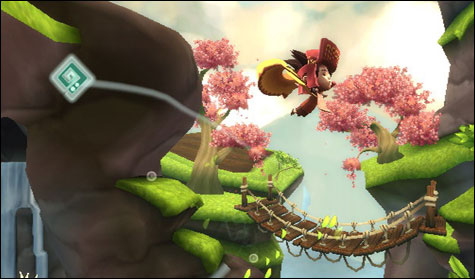
LIKE THE WIND: At $10, LostWinds is hardly a ripoff, but will anyone play it twice? |
| Lostwinds | For the Nintendo Wii | Rated E for Everyone | Developed and Published by Frontier Developments |
One of the most exciting aspects of this console generation has been each platform’s approach to downloadable content. Sony has pushed innovative original content, like the mind-bending Echochrome and the genre-defying fl0w. Microsoft’s Xbox Live Arcade has had its share of tempting original content, but its greatest contribution has been to release overhauled, HD-compatible editions of gems like Rez and Castlevania: Symphony of the Night. Nintendo had until recently stuck to its Virtual Console service, which offers emulated versions of older games. On May 12, Nintendo debuted the WiiWare service, its opening salvo in the battle for original, downloadable content. One of the first offerings: a charming little platformer called LostWinds.LostWinds’ innovation is to put you only minimally in control of your character, a lad named Toku. You can guide Toku left or right along the ground, but your real entree into the game world comes from using the Wii Remote to manipulate the wind. If Toku needs to jump, waving the remote will create a gust to sweep him in the right direction. Later, you acquire the ability to direct fire and water by tracing slipstream paths with the Remote (reminiscent of the Celestial Brush in Okami). As mighty as the wind can be, some of the game’s simplest pleasures come from just watching the trees sway with a player-created breeze. It’s an empowering mechanic.
The wind is the source of most of LostWinds’ triumphs, and most of its shortcomings. The play control works very well when all you’re doing is navigating the world. The problem is that the wind affects any object within its range, and many environmental puzzles demand precision placement. Say you need to settle a boulder on top of a pressure plate in order to open a nearby door. No problem there. But then, you need to make Toku jump over the boulder — and the wind has a tendency to roll the boulder off the plate. This isn’t a one-time gripe: most of the puzzles work this way.
Despite the game world’s small size, getting around can be tough. Characters frequently refer to other places by name, telling Toku to visit a particular locale in order to find a quest item. But there’s no way to tell, in-game, what area you’re in, or where you are relative to your destination. It’s not hard to figure out that “east” means right and “west” means left, but other than that, navigation is mostly trial-and-error. A map screen would have helped. (You can find maps on the Web that have been uploaded by altruistic LostWinds players — but should you have to?)
The game’s brevity is also a little offputting. Not its length per se — though I did polish it off in about two and a half hours — but the way the whole experience feels incomplete. The pacing is off. Toku acquires a couple of powers just in time for one neat boss battle. Then, though the game’s prologue promises a battle against an ancient monster that lives deep within the earth, you’re treated to a “To be continued!” screen. It’s a narrative letdown.
At $10, LostWinds is hardly a ripoff. Its charming æsthetic and inspired hook may make it worth a download, but I doubt anyone would ever play through it twice. And the low price doesn’t compensate for that “To be continued!” One of the best games of last year was the three-hour Portal, which was just about perfect. Short games can still be great games. Why should we settle for less?